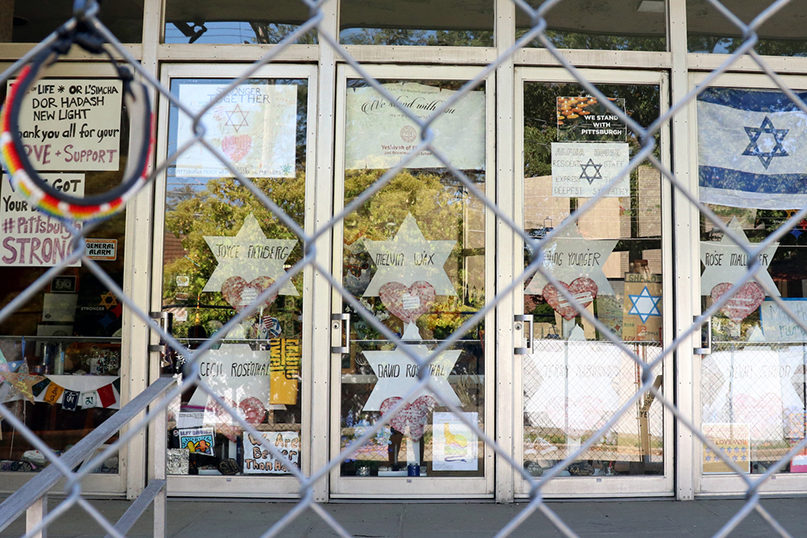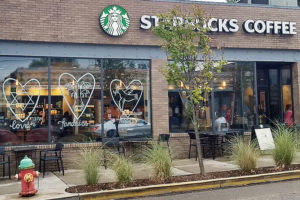
A year later, survivors of the Pittsburgh massacre continue to struggle
By Ben Sales
PITTSBURGH (JTA) – As this city’s Jewish community celebrated Rosh Hashanah two weeks ago, the Tree of Life synagogue stood closed, its doors blocked by a chain-link fence.
A brown, wilted wreath hung on a tree near the synagogue, where a gunman killed 11 worshippers last year in the worst antisemitic attack in American history. Jewish stars bearing the names of the victims are taped to a glass door at the front entrance, behind a fence and under an Israeli flag and a sign thanking first responders. A makeshift wooden sign on a barricade next to the building reads “No day shall erase you from the memory of time.”
The synagogue is built to welcome hundreds of Jews. But the only person to enter regularly now is a custodian who maintains the building while the three congregations that meet there decide what to do. Tree of Life has been shuttered since the attack.
“I hope it’s torn down,” said Ellen Surloff, who was president of one of the congregations, the Reconstructionist Dor Hadash, at the time of the shooting. “I don’t think that I could ever go back in that building and not be continually reminded of what took place there.”
Signs of the attack remain everywhere in Squirrel Hill, the quiet, warm, tree-lined community that has been the home to Pittsburgh’s Jews for more than a century, and which otherwise feels idyllic as summer turns into fall.

The window of the Starbucks in the Squirrel Hill neighborhood of Pittsburgh bears three hearts with the words “love,” “kindness” and “hope” written in English and Hebrew. (Ben Sales)
Local businesses display a sign created shortly after the attack that reads “Stronger than Hate” alongside a yellow Star of David and blue and red diamonds – the city’s traditional colors. The kosher supermarket hangs a banner with the names of the 11 victims. The local Starbucks has three large hearts painted on its windows with the words “love,” “kindness” and “hope” painted in Hebrew and English on each one.
As the first anniversary of the Oct. 27 attack nears, bearing up has become especially difficult. The shooting’s survivors and the rest of the community are just trying to get through the High Holidays – the busiest time of the Jewish calendar, when Jews are traditionally called to account for their souls.
“We’re figuring it out an hour at a time, a day at a time, what to do,” said Rabbi Jeffrey Myers of Tree Of Life*Or L’Simcha Congregation at a recent news conference.
As the shooting began, Myers dialed 911 from his cellphone and then rushed to protect his congregants.
“I live with Oct. 27 every minute of every hour of every day, and I will for the rest of my life,” he said. “Each of us finds the strength and courage to integrate what happened into our beings, to move forward.”
Every month, survivors of the Tree of Life shooting get together in a room to process their feelings. Many of them live next to each other in Squirrel Hill, and they can relax and schmooze about everyday life.
At the meeting last week, however, the conversation turned to the mechanics of getting past October. Some survivors attended Rosh Hashanah services in the neighborhood and will go to memorial events. Others will not, concerned that the communal prayers will be too painful. One person decided to leave home and rent an Airbnb for the weekend of Oct. 27 to avoid reporters who might come knocking.
There have been signs of progress, too. One survivor realized that 11 months after the attack, they could finally relax – a little. For the first time that year, the survivor didn’t feel the need to constantly monitor those who were entering and exiting the room.
“One of the people there had this aha moment and said, ‘I need to tell you all something: I am sitting with my back to the door,’” said Lulu Orr, the clinical specialist and care navigator from the Jewish Family and Community Services of Pittsburgh, who did not discuss the survivors’ personal details in order to respect their privacy. “They’re the only ones who experienced what they experienced. They support each other. They laugh with each other.”
Beyond the circle of survivors, the congregations that lived through the shooting are also figuring out how to move forward.
As needed, they are training people for the ritual chanting and prayers that used to be led by those who were killed. Rabbi Jonathan Perlman, who leads the Conservative New Light Congregation and survived the attack, composed a prayer in remembrance of the victims that was read during a section of the Yom Kippur service that commemorates Jewish martyrs throughout history.
“Like all the others, he did not deserve to die,” Perlman said at the news conference speaking of Melvin Wax, a congregant who was killed and remembered as a devoted grandfather, passionate baseball fan and energetic community volunteer. “That’s survivor’s guilt.
“I go through these scenarios in my mind, and I think a lot of other victims do, too, about I could have done more, I could have saved people, why did this person choose to do x, y and z, why did they turn the other way. And it’s part of the trauma, and it’s part of being human. You carry those kinds of things with you.”
Dor Hadash met for Rosh Hashanah in the local Jewish community center, with survivors of the shooting in attendance but a new person blowing the shofar. The usual shofar blower, Jerry Rabinowitz, was killed in the attack. Daniel Leger, who was injured, spoke to the congregation on Yom Kippur.
Surloff, the Dor Hadash president, was not at the synagogue when the gunman entered: She was feeling sick and came late. She recalls seeing a row of police cars surrounding the building.
When Surloff told a policewoman, “I have to go, that’s my synagogue,” the officer gave her a hug and did not let her pass. The synagogue leader later found out that Rabinowitz, a mainstay of the congregation, had been killed.
“Not only was he such an integral part and member of the congregation, but he was also a really important part of the congregation at the time of the High Holidays,” Surloff said. “Jerry was in charge of the greeting and ushering. You walk in the door and there was Jerry with his smiling face.”
Some community members and survivors said that amid the stream of commemorative events, logistical decisions and media interviews, they have not had time to even begin processing the shooting. A few refer to the day as “10/27,” giving it a name similar to 9/11.
Surloff said that the four months after that day were consumed with meetings on everything from insurance claims to finding a new prayer space to writing thank-you notes to those who had reached out after the shooting.
Orr of Jewish Family and Community Services said about the attack survivors, “This past year has been very public, and they really believe that Oct. 28 of this year will be the first day of their grief journey.”
Main Photo: The doors of the Tree of Life synagogue feature memorials surrounding the building nearly a year after the attack there that killed 11 worshippers. (Grace Yagel)
How Pittsburgh changed the way American Jews think about security
By Ron Kampeas
WASHINGTON (JTA) – Here’s the sad paradox of the shooting nearly one year ago at Pittsburgh’s Tree of Life synagogue: The killing of 11 worshippers, the worst attack on Jews in U.S. history, hit a community that was one of the best prepared to handle such an assault.
In the year or so prior to the attack, Jewish community security officials had run dozens of training sessions that reached as many as 5,000 Pittsburgh Jewish residents. Many of the Tree of Life congregants knew not to stay in place during an attack, where to find the exits and to have a cellphone on hand to call 911 – despite the compromise to traditional Shabbat observance that requires avoiding the use of electronic devices.
“It was an incredible model that needs to be replicated,” Michael Masters, the CEO of the Secure Community Network (SCN), the security agency for the national Jewish community, told the Jewish Telegraphic Agency. “The loss of life would have been much more significant.”
The horror that was the Pittsburgh attack, and the fact that it might have been much worse, has served as a wake-up call for Jewish Americans. Here’s what’s changed in the last year as the attack’s Oct. 27 anniversary approaches.
Communities are paying more attention
Masters told a Jewish Council for Public Affairs webcast earlier this month that requests to SCN for assistance had quadrupled from 500 in the year before the attack to 2,000 since. Thirty-five federations had security directors a year ago; now 44 do.
SCN, a program launched in 2004 by the Jewish Federations of North America and the Conference of Presidents of Major American Jewish Organizations, expanded in the months before Pittsburgh by hiring regional directors to target areas of the country where communities have less well-developed security operations. There are now five such directors, and more are in the works.
Attitudes have changed, too. Masters said he no longer encounters communities that believe attacks on Jewish institutions only happen overseas, or that enhanced security attracts unwanted attention, as he occasionally did before Pittsburgh.
“There’s now a general consensus on the importance of security,” he said.
Still, while Federations may be hiring more security directors, Masters said, some are slow in getting around to providing them with the support necessary to run training sessions and threat assessments.
“We still have a lot to do to make people understand this is a collective responsibility,” he said. “Every organization should be training on key elements [of responding to attacks]: situational awareness, threat assessments, stopping the bleeding.”
Standardization is key, Masters said. It doesn’t help a community if the Jewish day school has a better security system in place than the summer camp the same children attend.
The normalization of violent antisemitism
Antisemitism appears more prevalent and knows no political home, said Jonathan Greenblatt, the Anti-Defamation League CEO. He cited the recent proliferation of attacks on Orthodox Jews in the New York area, especially in Brooklyn.
“You can’t just plug this into a political lens,” Greenblatt said. “There are no white supremacists and [far-left] activists in Williamsburg.”
The attacks are also happening everywhere. Masters noted the geographical breadth of a number of foiled mass attacks since Pittsburgh: Washington state, California, Ohio, Georgia.
The ADL and the Jewish Federations of North America, SCN’s parent group, have convened a joint security task force co-chaired by two former Homeland Security secretaries, Jeh Johnson and Michael Chertoff. The task force will release its findings at about the time of the Pittsburgh anniversary, Greenblatt told JTA.
Recognizing white supremacists as the danger
Since 2017, when a group of white supremacists marched in Charlottesville, Virginia, the ADL has emphasized that the majority of terrorist violence in the United States since 9/11 have come from the far right. The Trump administration for a time seemed reluctant to accept this assertion, with the president in March dismissing white nationalist violence as a major threat and calling white supremacists “a small group of people.”
But that may have changed last month when the Department of Homeland Security released a new strategy document for confronting terrorism that acknowledged the threat.
“There has been a concerning rise in attacks by individuals motivated by a variety of domestic terrorist ideologies, such as racially- and ethnically-motivated violent extremism, including white supremacist violent extremism, anti-government and anti-authority violent extremism, and other ideological strains that drive terrorist violence,” the document said.
Masters welcomed the shift, saying in a statement that the document “rightly recognizes the growing threat of domestic terrorism, and specifically notes recent attacks on the Jewish community.”
Last month, the ADL released a report warning of the internationalization of white supremacy, with groups in the U.S., Europe and beyond forging ties and learning from one another.
“We drew the links of what was happening in our country and around the world and co-wrote the report with European institutions,” Greenblatt said.
Meanwhile, federal and state lawmakers are hastening to fund security for nonprofits. The federal program that disburses funds to protect nonprofits, most of them Jewish, now budgets $60 million – more than double what it did in the years since its 2005 launch, when the average was $15 million to $25 million a year. Florida, Ohio, New Jersey, New York, Maryland and Pennsylvania have also budgeted for nonprofit security grants.
Social media
The ADL is working closely with social media giants to mitigate the organizational and recruiting capacity that they lend to extremists. Facebook placed restrictions on its Facebook Live video app after the Christchurch gunman used it during the massacre. YouTube reportedly is altering algorithms that have directed viewers to radical right-wing content.
Greenblatt praised Facebook and YouTube for setting up mechanisms over the last year to quickly take down videos that glorify or promulgate violence, but said more needed to be done. He called on businesses ancillary to the social media giants to take action, saying that some companies now decline to provide extremist sites with security support.
“The ancillary businesses can take affirmative decisions about whether to be part of these ecosystems,” he said.







 Southern New England Jewish Ledger
Southern New England Jewish Ledger













